Voyager One
Thanks to Marcus Lindroos.
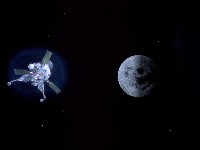
|
The Voyager One spacecraft was launched in 1985 "to probe the galaxy for signs of intelligent life, to find habitable solar systems, to make man's presence known in the galaxy." Voyager is powered by the "Queller Drive", "an atomic engine used for going across space at incredible speed" according to Koenig (faster-than-light travel had not yet been invented, though). The engine generates "fast neutrons" which are (according to Paul Morrow) "spewed out into space, annihilating everything in their path. You'd survive better standing smack in the middle of a nuclear explosion". The Voyagers were designed to carry crews but the design proved too dangerous (Voyager 2 accidentally destroyed a space community of 200 inhabitants in the mid-1980s when its Queller drive cut in too soon). Consequently only the first unmanned, experimental spacecraft was launched. |
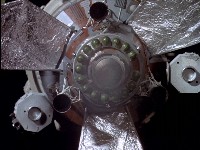
|
As described in the episode, the Queller Drive seems remarkably similar to antimatter-induced nuclear fusion propulsion. Antimatter has the highest "energy density" known to man: one kilogram would produce as much energy as a 21 megaton nuclear explosion! It does not occur naturally on Earth as it immediately annihilates on contact with ordinary matter. Probably the easiest space propulsion application would require manufacturing small amounts of antiprotons using particle accelerators (the basic technology already exists but would have to be scaled up by a few orders of magnitude). The antiprotons would then be stored magnetically inside a spacecraft. One antiproton and one proton annihilate to produce short-lived elementary particles called pions; an average of 1.5 positively charged pions, 1.5 negatively charged ones and 2 neutral pions. The neutral pions quickly decay to gamma rays and cannot be directed. The longer-lived charged pions could however be used to heat a reaction propellant such as hydrogen or water which would then be channelled into a directed exhaust, before the charged pions have decayed into gammas rays a few tens of meters behind the spaceship. |
|
|
Robert Forward has estimated that 30-50% of the matter/antimatter annihilation energy could be transformed into high velocity exhaust produced by nuclear fusion. Forward's calculations indicate a small 1000kg spacecraft could reach a speed of 0.10c (10% of the speed of light) using only 4000kg of propellant plus just 18kg of antiprotons - fast enough to travel to the nearest star system in only 40 years. However, this engine would be quite dangerous to nearby spacecraft and planets as the gamma ray high-energy particle exhaust would travel thousands of kilometres away from the spacecraft. It would be necessary to avoid pointing the engine at inhabited planets. The spaceship would also need large radiators and heavy radiation shielding against the deadly gamma rays produced by the matter-antimatter annihilation process. For these reasons, a practical engine would probably only produce a very low thrust (only microscopic amounts of antimatter are annihilated per second) although it would be highly fuel efficient. Consequently the engine would have to operate continuously for years in deep space while slowly accelerating the spacecraft to extremely high velocities. |
|
A matter/antimatter spacecraft of the type described above would permit very fast travel within our own solar system, but it is not clear how Voyager One managed to reach "the Sidon worlds of the outer galaxy" in only 15 years. The Bringers of Wonder establishes that faster-than-light travel is impossible, so consequently Voyager One must have been transported across space and time by some unknown cosmic phenomenon. 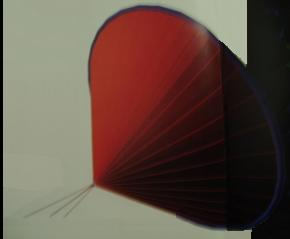
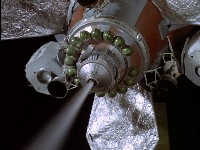
The "Queller drive" compared to antimatter induced fusion engine, as depicted in Nicholas Booth's Space: The Next 100 Years. The antiprotons are annihilated near the "rim" of the conical structure and the resulting charged pions are directed towards the end of the cone, where they heat reaction propellant to very high temperatures. |
|
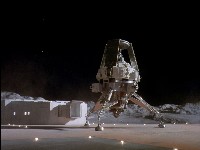

|
The saucer shaped top attachment is probably a micro-meteoroid shield; even a small dust particle travelling at tens of thousands of kilometres per second, would cause significant damage to an unprotected spacecraft. The bay on top apparently contains storage tanks, a steerable antenna dish and other subsystems equipment. The pressurised main section has a diameter of about 27cm / 10.5in. The model is obviously the same scale as the 1/24 scale Eagle landing pad, so the Voyager would be approximately 6.4 metres / 21 feet across. However, the interior set (designed by Keith Wilson) is much larger at 28 feet (see Interior Set article). The wing panels that fold up on landing are probably radiators rather than solar panels. |

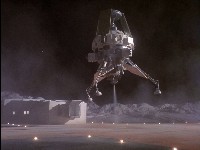
|
The Voyager landing gear is clearly inspired by NASA's unmanned Surveyor lunar probe from the late 1960s. These probes also had three landing legs. The high-thrust chemical rockets would be used during launch and landing. In the episode, we see the central rocket firing during launch and landing (just as it does in space during the Queller Drive sequences). The side boosters do not fire at all. |
Copyright Martin Willey